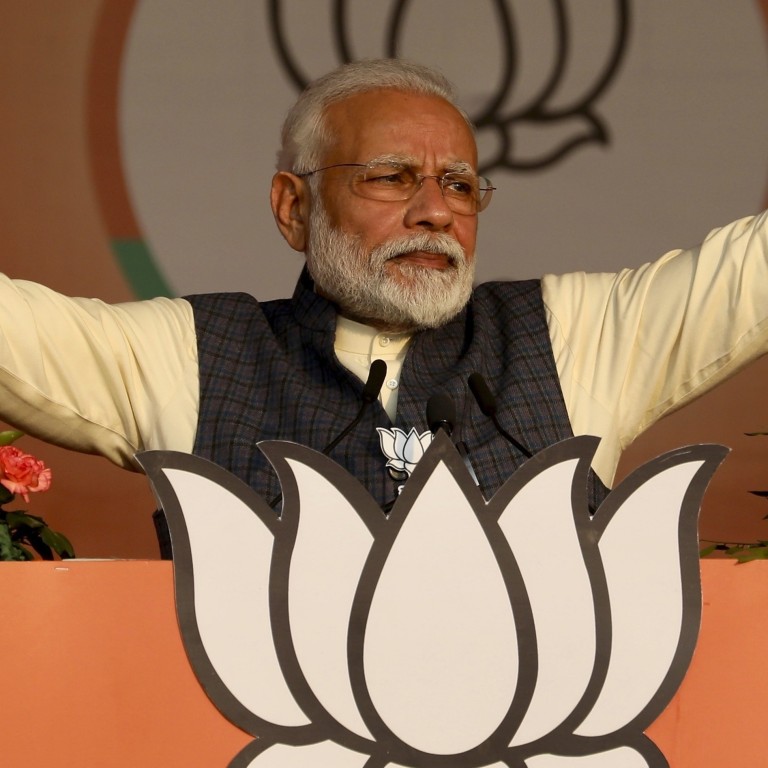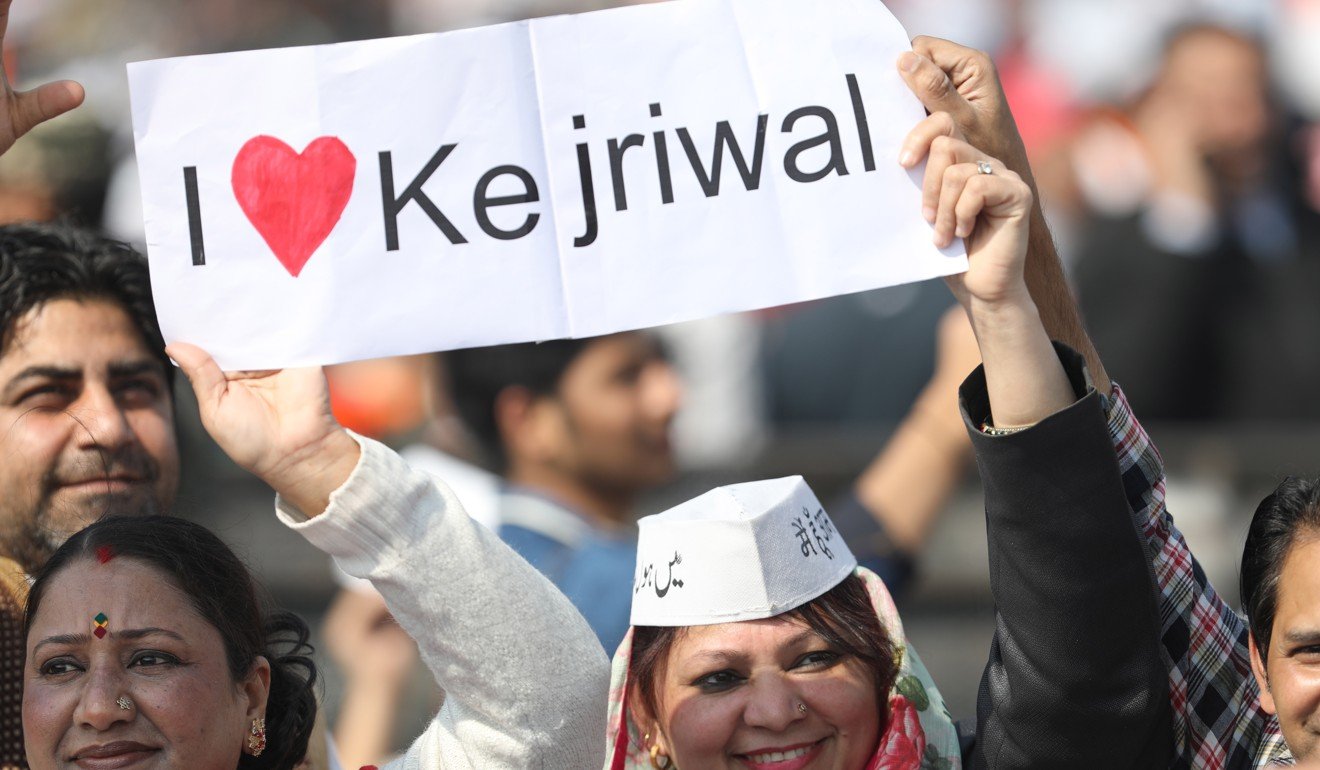
What does New Delhi election reveal about the best way to defeat Narendra Modi and BJP?
- By delivering on education and avoiding identity politics, Chief Minister Arvind Kejriwal steered his Aam Admi Party to victory
- However, winning the Indian capital is no proof you can win the country – that will require greater cooperation and regional alliances
Nevertheless, relations between the two giants are far from perfect, as trade and investment disputes cast long shadows.
To add insult to injury, earlier this month, Modi suffered an electoral defeat in the Delhi Legislative Assembly Elections. The Bharatiya Janata Party (BJP), with all its money, media backing and vitriolic anti-Muslim attacks, failed to dislodge the Aam Admi (“common man”) Party (AAP) and its unassuming leader, Chief Minister Arvind Kejriwal. The AAP won 62 of Delhi’s 70 Assembly seats with the BJP taking the rest.
Trump has plenty of fans in India. They even built a wall for his visit
Kejriwal, a former tax official, is the polar opposite of the bombastic Modi and his allies such as firebrand monk Yogi Adityanath and hardline Home Minister Amit Shah.
In 2011, Kejriwal, with Gandhian icon Anna Hazare, fronted massive nationwide protests seeking to pressure India’s government to set up a “Jan Lokpal” (ombudsman) anti-corruption body with far-reaching powers. Breaking with Hazare, Kejriwal formed the AAP in 2012 before winning power in Delhi’s 2013 Assembly elections and again in 2015.
Fast-forward to 2020 and the BJP went all-out against Kejriwal, labelling him a “terrorist” for supposedly being soft on the peaceful female Muslim sit-in protesters blockading the Shaheen Bagh area – a crucial traffic artery – over the Citizenship Amendment Act.
Yogi Adityanath accused Kerjiwal of sending biryani rice to the women. Amit Shah urged Delhi voters to vote for the BJP by pressing the voting machine buttons “with such anger that its current is felt at Shaheen Bagh”. Yet it was the BJP that was jolted. So how did Kejriwal do it?

First, he delivered. He may have failed to create the Jan Lokpal due to federal obstruction but Kejriwal’s administration has provided Delhi’s poor with free electricity and primary health care, as well as improved public schools – it spends 25 per cent of its 600 billion rupee (US$8.3 billion) budget on education.
Compare this to the hash Modi has made of India’s economy: it’s expected to grow just 5 per cent (an 11-year low) while inflation stands at 7.59 per cent. Urban unemployment in January 2020 stood at 9.7 per cent.
Second, Kejriwal avoided the BJP’s obsession with identity politics. He conceded the Shaheen Bagh protesters had the right to demonstrate but that the roads ought to be open – in effect avoiding backing them openly. Furthermore, he rightly argued that power to clear the area resided with Amit Shah as home minister.
Secularism does not mean negation of personal faith. It means that the state must not discriminate between religions
Shah responded: “I say let’s make more schools; they say Shaheen Bagh … I say, let’s build more hospitals; they say Shaheen Bagh. I talk about uninterrupted power supply; they say Shaheen Bagh. Is there no other issue in Delhi?”
Finally, the AAP embraced patriotism and faith. Unlike the Congress party, which didn’t win a single seat, the AAP supported the abrogation of the special status of Jammu and Kashmir.
Despite controversy, Kejriwal visited Delhi’s Hanuman temple during and after the campaign. His victory address featured patriotic slogans like “Bharat Mata Ki Jai” (“Victory for Mother India”), “Inquilab Zindabad” (“Long Live the Revolution”) and “Vande Mataram” (“I praise Thee, Mother”).
Kejriwal’s appropriation of Indian nationalism and Hindu culture can be dismissed as self-serving. But both are here to stay.

However, the AAP’s example shows this does not mean throwing minorities under the bus. And there’s no point trumpeting pluralism if you do nothing to reduce socio-economic injustices.
As Sagarika Ghose wrote in her column with The Times of India: “Secularism does not mean negation of personal faith. It means that the state must not discriminate between religions. The innovation of AAP is that by treating Hinduism as purely cultural, it refuses to compete on the BJP’s terms and get tangled up in BJP’s pet controversies.”
Conversely, the BJP’s hardline approach destroyed their own base of support. The AAP became the only viable choice for Delhi’s Muslims (12 per cent of its population). Meanwhile, the BJP was just another option for their Hindu compatriots and not a great one at that.
So does that make Kejriwal Modi’s nemesis? Perhaps not. Winning the capital is no proof you can win the country. Also, Delhi’s voters may have simply voted tactically: the developmentally minded AAP locally and the ideologically driven BJP for the centre.
India’s marginalised minorities unite against Hindu nationalism
Indian electors tend to go against the national incumbent in regional contests: Modi still won in 2019 despite the BJP losing six state elections since December 2018.
The real story of the Delhi Assembly elections is the continuing slide to irrelevance of Congress.
Beating the authoritarian Modi will require a strong national leader coordinating anti-BJP regional players. That’s how Sonia Gandhi propelled Manmohan Singh to the premiership in 2004 – by forming alliances with leftist and regional parties.
This has not happened under her son, Rahul. Until someone can, Modi’s BJP will mirror the deity, Jaganath, from which the word juggernaut derives: “Lord of the Universe” and virtually unstoppable.

